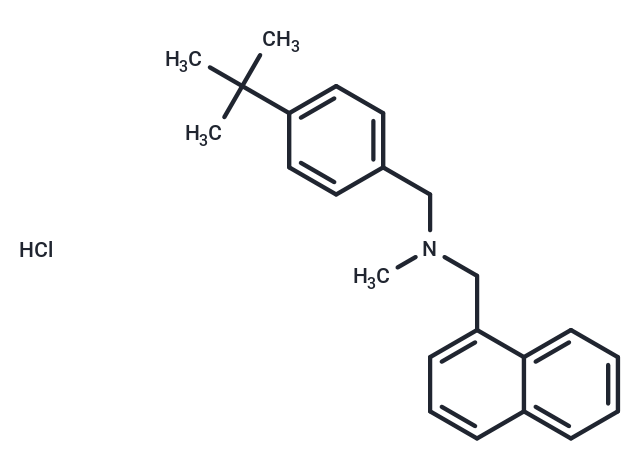Shopping Cart
- Remove All
 Your shopping cart is currently empty
Your shopping cart is currently empty

Butenafine hydrochloride (KP363 Hydrochloride) is a synthetic benzylamine antifungal, inhibiting the synthesis of sterols by inhibiting squalene epoxidase.

| Pack Size | Price | Availability | Quantity |
|---|---|---|---|
| 200 mg | $31 | In Stock | |
| 500 mg | $53 | In Stock | |
| 1 g | $81 | In Stock | |
| 1 mL x 10 mM (in DMSO) | $57 | In Stock |
| Description | Butenafine hydrochloride (KP363 Hydrochloride) is a synthetic benzylamine antifungal, inhibiting the synthesis of sterols by inhibiting squalene epoxidase. |
| In vitro | Butenafine HCl shows minimum inhibitory concentrations ranging from 0.03–1.0 μg/mL against 30 isolates representing different dermatophyte species. Butenafine shows limited activity against C. albicans and no activity against M. furfur against 10 isolates of two species of yeasts. Butenafine HCl shows activity against β-hemolytic Streptococcus Group A and Corynebacterium but failed to inhibit S. aureus against 25 isolates representing different Gram-positive bacteria species. Butenafine fails to show activity against any of the Gram-negative strains tested. [1] Butenafine interferes with fungal ergosterol biosynthesis by inhibiting the conversion of squalene into squalene epoxide which is catalyzed by squalene epoxidase. Butenafine shows activity against KD-04 and KD-305 with minimum inhibitory concentrations of 12 ng/mL. [2] |
| In vivo | Butenafine (1%, once daily) shows excellent efficacy against dermatophytosis in male hartley strain guinea pigs, and the effect is superior to those of naftifine, tolnaftate, clotrimazole, and bifonazole. Butenafine (1%) exhibits excellent prophylactic efficacy against experimental T. mentagrophytes infection when apply once at 24 or 48 h before infection. [2] After 16 weeks, 80% of patients using medicated cream incorporating 2% butenafine HCl are cured, as opposed to none in the placebo group. Four patients in the active treatment group experience subjective mild inflammation without discontinuing treatment. During follow-up, no relapse occurres in cured patients and no improvement is seen in medication-resistant and placebo participants. [3] Butenafine (1% cream) applied once daily for 4 weeks results in an effective clinical response and mycologic cure of tinea pedis during treatment in patients with positive fungal cultures. [4] Butenafine hydrochloride (1% cream) alone is extremely effective for the treatment of hyperkeratotic-type tinea pedis patients. [5] |
| Alias | KP-363 HCl, KP363 (Hydrochloride), Butenafine HCl |
| Molecular Weight | 353.93 |
| Formula | C23H27N·HCl |
| Cas No. | 101827-46-7 |
| Smiles | Cl.C(c1ccc(cc1)CN(C)Cc1cccc2c1cccc2)(C)(C)C |
| Relative Density. | 1.032g/cm3 |
| Storage | Powder: -20°C for 3 years | In solvent: -80°C for 1 year | Shipping with blue ice. | |||||||||||||||||||||||||||||||||||
| Solubility Information | DMSO: 45 mg/mL (127.14 mM), Sonication is recommended. Ethanol: 65 mg/mL (183.65 mM), Sonication is recommended. H2O: < 1 mg/mL (insoluble or slightly soluble) | |||||||||||||||||||||||||||||||||||
Solution Preparation Table | ||||||||||||||||||||||||||||||||||||
DMSO/Ethanol
| ||||||||||||||||||||||||||||||||||||

Copyright © 2015-2025 TargetMol Chemicals Inc. All Rights Reserved.